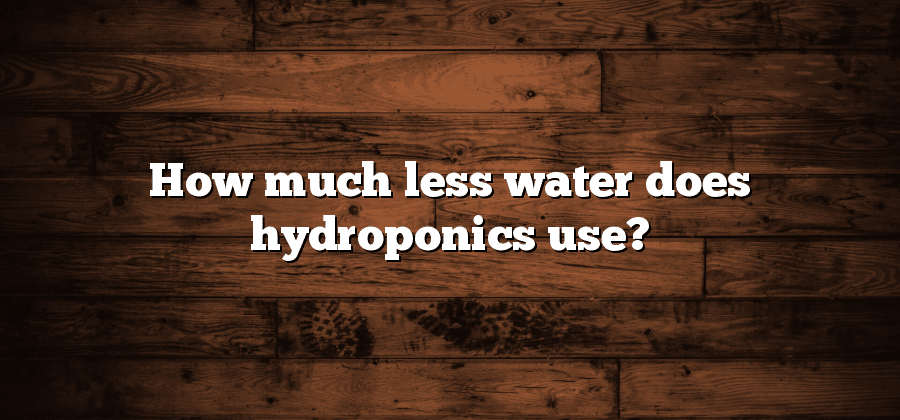Efficient water utilization in hydroponics
Hydroponics, a soilless farming method, holds great promise for addressing the challenges of water scarcity and sustainable agriculture. One of the key advantages of hydroponics lies in its ability to efficiently utilize water resources. Unlike traditional soil-based farming, hydroponics utilizes a closed-loop system that recirculates and reuses water, thereby reducing water wastage and promoting efficient water management.
In hydroponics, water is delivered directly to the plant roots, providing them with a precise amount of water they need to thrive. By closely monitoring and controlling the water supply, hydroponic farmers can prevent overwatering and minimize water loss through evaporation or runoff. Additionally, advanced hydroponic systems incorporate technologies such as drip irrigation or aeroponics, which further optimize water usage by delivering water precisely to each plant, minimizing water waste, and promoting faster plant growth. Overall, the focus on efficient water utilization in hydroponics not only conserves water but also maximizes crop yields, making this farming method a sustainable solution for the future.
Water-saving techniques in hydroponics systems
Hydroponics, a soil-less method of cultivating plants, has gained popularity due to its ability to produce high yields in a controlled environment. With water scarcity becoming a global concern, incorporating water-saving techniques in hydroponics systems has become paramount. By implementing efficient water utilization strategies, hydroponic growers can not only reduce their water consumption but also contribute to sustainable agriculture practices.
One of the most effective water-saving techniques in hydroponics is the use of recirculating systems. In these systems, the nutrient-rich water is continuously circulated through the root zone, ensuring that every drop is utilized by the plants. This eliminates the need for excessive watering and minimizes water wastage. Additionally, the recirculating systems often incorporate technologies such as drip irrigation or misting, which further optimize water usage by delivering the right amount of water directly to the plants’ roots.
Comparison of water usage between hydroponics and traditional farming
Traditional farming and hydroponics are two vastly different methods of cultivation that require varying amounts of water. In traditional farming, water is typically applied to the entire field, saturating the soil and providing moisture for the plants. This can lead to significant water loss due to evaporation, as well as runoff that carries away valuable nutrients. On the other hand, hydroponics involves a controlled system where water and nutrients are directly supplied to the roots of the plants, ensuring maximum efficiency and minimal waste. This targeted application of water greatly reduces water usage compared to traditional farming methods.
Moreover, hydroponic systems can be designed to recirculate and reuse water, further minimizing water consumption. By continuously circulating the nutrient-rich solution through the roots of the plants, hydroponics eliminates the need for excessive watering. In contrast, traditional farming methods often result in water being absorbed by the surrounding soil, leaving the plants without access to an adequate water supply. As a result, traditional farming systems require continuous irrigation, leading to larger amounts of water being used overall. In this context, hydroponics stands out as an innovative and sustainable solution for conserving water resources in agriculture.
Factors affecting water usage in hydroponics
One key factor that affects water usage in hydroponics is the type of hydroponic system being used. Different systems have varying levels of water consumption due to factors such as the design and structure of the system, as well as the method of nutrient delivery. For example, deep water culture systems tend to require more water as they submerge the plant roots entirely in a nutrient solution, whereas drip irrigation systems use a more targeted approach, delivering water directly to the roots. Therefore, farmers considering implementing hydroponics should carefully consider the type of system that best suits their needs, taking into account their water availability and efficiency goals.
Another factor that influences water usage in hydroponics is the cultivation method chosen. Hydroponics offers numerous techniques, such as nutrient film technique, aeroponics, and ebb and flow, each with its own water requirements. Additionally, the choice of growing medium also plays a role in water usage. Systems using aggregate mediums, such as perlite or clay pebbles, may require more water as the material tends to retain moisture. On the other hand, systems utilizing inert mediums like rockwool or coco coir may provide better water drainage and help conserve water. Thus, careful selection of cultivation methods and growing mediums is crucial in optimizing water usage in hydroponics.
Innovations in hydroponic systems for water conservation
Hydroponic systems have made significant advancements in recent years with regards to water conservation. One notable innovation is the use of recirculating systems, where the nutrient solution is continuously recirculated through the plants, minimizing water waste. These systems make use of pumps and filters to maintain the correct nutrient levels in the solution, ensuring optimal plant growth while reducing overall water usage. Additionally, some advanced hydroponic systems incorporate automated monitoring and control mechanisms, allowing for precise water management based on specific plant requirements. This not only reduces water waste but also improves the overall efficiency of water utilization in hydroponics.
Another innovative approach in hydroponic systems for water conservation is the use of alternative growing mediums. Traditionally, hydroponics relies on inert mediums like rockwool or perlite, which require frequent flushing to prevent salt build-up. However, newer methods explore the use of natural, water-absorbent materials such as coconut coir or peat moss. These materials can retain water effectively and gradually release it to the plants, minimizing the need for frequent irrigation. By adopting these alternative growing mediums, hydroponic systems can significantly reduce water consumption, making them more sustainable and environmentally friendly.






